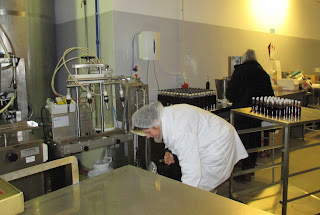The first full day for our leadership group started with a beautiful breezy day seeing the green countryside on our way to LucObidos. The sour cherry lequeur is is ran by Kristina and her son, Bernado, while her husband is hands on at the farm. They have learned to market their product by specializing it to each country that they ship to. Bernado showed us the different stages the liqueur is in the vasts. They have created chocolates that contain the liqueur. The packaging is done a lot by hand right in the factory.
Virgil Merano and Anna his wife hosted the leadership group for a taste of his produce for lunch after a tour of the olive trees. Virgil is eager to share why it is important to maintain his organic produce and provide opportunities to learn and be in the ag industry.
The most important Portuguese School in Sanharem gave us a brief tour an idea of their ag school of nearly 1,500 students. The annual tuition of $900 year and 97% placement of its graduate. The majority of the students were employed in the either the wine or olive oil industries. Students come from all over Europe and the have many students that take advantage of exchange programs. The also offer Master's program in their main areas of agronomy, animal science and ag technology.
We spent the majority of our afternoon at the Amorim cork factory in Coruche. Our tour guide was amazing and had a great amount of passion about the industry of Cork. Joana Mesquita had a chemical engineering degree and work for the company for over 16 years. The industry produces 12 billing corks for wine bottles per year and 4.3 billion of them come from her company. She stated that 30% of their cork they purchase is used for the wine bottles but produces 70% of the income. They typically sell the corks for two cents to $2 but can sell a cork for as much as $20 per cork. The better the cork the better the wine and the longer the wine can be aged. The cork is harvested on average every 9 years. The third harvest can be used for cork and the tree can live for approximately 200 years.







